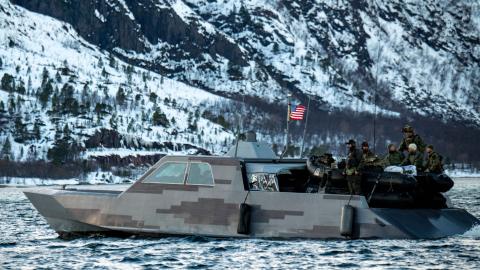Even as its members take part in Steadfast Defender 2024, NATO’s largest military exercise since the Cold War, it is clear that the alliance remains ill-prepared against Russia’s military capabilities in the Arctic. The exercise, which runs between January and May, involves more than 90,000 troops across the Atlantic and up to the Arctic and suggests that NATO has a strong and capable defense presence in the region.
However, a closer look at the capabilities of the Arctic states—which are all NATO members except Russia—reveals otherwise. Finland and Sweden’s recent membership in NATO has been heralded as a turning point in deterrence against Russia in the north. However, the countries’ proximity to northwest Russia means that their strategic focus is primarily targeted at the Baltic Sea region, where Russia has pursued a military buildup directed toward NATO’s eastern flank.
No NATO member state has ice-strengthened ships with both anti-aircraft and anti-submarine capabilities. The United States, Canada, Denmark, Finland, and Sweden have prioritized capabilities designed for other theaters, such as the Indo-Pacific and the Baltic Sea regions. Iceland, which has no standing army, only operates coast guard vessels. Norway has ice-strengthened coast guard vessels, but they are not designed for military operations.
Russia’s nuclear submarines, which are capable of launching an attack on North America, can travel from the Barents Sea through the Bear Gap between Scandinavia and Svalbard, Norway, and under the ice along the coast of eastern Greenland without being detected. This leaves big gaps in NATO’s defense posture. Russia’s war in Ukraine also gives it incentives to work with China in the Arctic, including joint naval exercises and coast guard cooperation.
NATO should not let Arctic deterrence fall by the wayside by concentrating its force posture along its eastern flank. Instead, the trans-Atlantic alliance must act urgently.
Russia’s 2022 naval doctrine raised the Arctic region to the highest priority. Between its invasion of Crimea in 2014 and 2019, Russia built more than 475 military facilities in the Arctic. Its Northern Fleet, located in the Barents Sea, accounts for around two-thirds of the Russian Navy’s nuclear strike capabilities. A multilayered network of sensors, missile systems, coastal defense systems, and electronic warfare technology protects these capabilities, including the strategic submarines.
Despite NATO Secretary-General Jens Stoltenberg sounding the alarm in 2022, the alliance lacks an Arctic strategy. Its current area of responsibility extends only to the “High North,” a less ambitious term that describes the ice-free parts of the Arctic. The term is indicative of disagreement within NATO over whether its remit goes beyond the North Atlantic.
As glaciers melt, more countries from outside the region are engaging in the Arctic, which risks further crowding the Northern Sea Route and incentivizing Russia to protect the entry and exit points to its military bastion.
Russian vulnerabilities in the Arctic have affected its strategic cooperation with China. On the one hand, Russia needs to cooperate more with Beijing—in areas such as digitalization; infrastructure; and intelligence, surveillance, and reconnaissance—to utilize the economic potential of the Northern Sea Route and protect its strategic assets. On the other hand, Russia is concerned with maintaining control of its Arctic coastline.
Moscow will cooperate with Beijing if this red line is respected. Although access to Russian facilities and ports will allow China to use its military capabilities in the Arctic, including icebreakers and semi-submersible vessels, Beijing has little interest in becoming a military power in the region. Decades of strategic coordination in Central Asia and in the Korean Peninsula have proved that China understands the benefits of not undermining Russia, even if Moscow’s geopolitical agenda is not always to Beijing’s liking.
Despite Chinese concerns over Russia’s war of attrition in Ukraine and its military-strategic cooperation with North Korea, Beijing benefits from Moscow maintaining a strong force posture toward NATO. This is especially true in the case of the Arctic, where a permanent Chinese presence would open a new front with U.S. allies at a time when Beijing is already engaged in hot spots in its own backyard.















